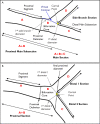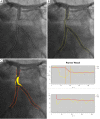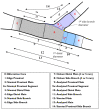QCA, IVUS and OCT in interventional cardiology in 2011
- PMID: 24282685
- PMCID: PMC3839131
- DOI: 10.3978/j.issn.2223-3652.2011.09.03
QCA, IVUS and OCT in interventional cardiology in 2011
Abstract
Over the past 30 years, quantitative coronary arteriography (QCA) has been used extensively as an objective and reproducible tool in clinical research to assess changes in vessel dimensions as a result of interventions, but also as a tool to provide evidence to the interventionalist prior to and after an intervention and at follow-up when necessary. With the increasing complexities of bifurcation stenting, corresponding analytical tools for bifurcation analysis have been developed with extensive reporting schemes. Although intravascular ultrasound (IVUS) has been around for a long time as well, more recent radiofrequency analysis provides additional information about the vessel wall composition; likewise optical coherence tomography (OCT) provides detailed information about the positions of the stent struts and the quality of the stent placement. Combining the information from the X-ray lumenogram and the intravascular imaging devices is mentally a challenging task for the interventionalist. To support the registration of these intravascular images with the X-ray images, 3D QCA has been developed and registered with the IVUS or OCT images, so that at every position along the vessel of interest the luminal data and the vessel wall data by IVUS or the stent strut data by OCT can be combined. From the 3D QCA the selection of the optimal angiographic views can also be facilitated. It is the intention of this overview paper to provide an extensive description of the techniques that we have developed and validated over the past 30 years.
Keywords: 3D reconstruction; Coronary artery disease; IVUS; OCT; QCA; registration.
Figures








Similar articles
-
Fusion of 3D QCA and IVUS/OCT.Int J Cardiovasc Imaging. 2011 Feb;27(2):197-207. doi: 10.1007/s10554-011-9809-2. Epub 2011 Jan 25. Int J Cardiovasc Imaging. 2011. PMID: 21264684 Free PMC article.
-
In vivo comparison of arterial lumen dimensions assessed by co-registered three-dimensional (3D) quantitative coronary angiography, intravascular ultrasound and optical coherence tomography.Int J Cardiovasc Imaging. 2012 Aug;28(6):1315-27. doi: 10.1007/s10554-012-0016-6. Epub 2012 Jan 20. Int J Cardiovasc Imaging. 2012. PMID: 22261998 Free PMC article.
-
Accurate and reproducible reconstruction of coronary arteries and endothelial shear stress calculation using 3D OCT: comparative study to 3D IVUS and 3D QCA.Atherosclerosis. 2015 Jun;240(2):510-9. doi: 10.1016/j.atherosclerosis.2015.04.011. Epub 2015 Apr 13. Atherosclerosis. 2015. PMID: 25932791
-
Optical Coherence Tomography: An Eye Into the Coronary Artery.Front Cardiovasc Med. 2022 May 11;9:854554. doi: 10.3389/fcvm.2022.854554. eCollection 2022. Front Cardiovasc Med. 2022. PMID: 35647059 Free PMC article. Review.
-
Meta-analysis of angiographic versus intravascular ultrasound parameters of drug-eluting stent efficacy (from TAXUS IV, V, and VI).Am J Cardiol. 2007 Aug 15;100(4):621-6. doi: 10.1016/j.amjcard.2007.03.076. Epub 2007 Jun 29. Am J Cardiol. 2007. PMID: 17697817 Review.
Cited by
-
FlyNet 2.0: drosophila heart 3D (2D + time) segmentation in optical coherence microscopy images using a convolutional long short-term memory neural network.Biomed Opt Express. 2020 Feb 21;11(3):1568-1579. doi: 10.1364/BOE.385968. eCollection 2020 Mar 1. Biomed Opt Express. 2020. PMID: 32206429 Free PMC article.
-
Stent visualization methods to guide percutaneous coronary interventions and assess long-term patency.World J Cardiol. 2021 Sep 26;13(9):416-437. doi: 10.4330/wjc.v13.i9.416. World J Cardiol. 2021. PMID: 34621487 Free PMC article. Review.
-
Integrating genomic profiling to clinical data: assessing the impact of CD147 expression on plaque stability.Front Cardiovasc Med. 2024 Sep 13;11:1425817. doi: 10.3389/fcvm.2024.1425817. eCollection 2024. Front Cardiovasc Med. 2024. PMID: 39355350 Free PMC article.
-
A novel computer-aided diagnostic approach for detecting peripheral arterial disease in patients with diabetes.PLoS One. 2018 Jun 21;13(6):e0199374. doi: 10.1371/journal.pone.0199374. eCollection 2018. PLoS One. 2018. PMID: 29928037 Free PMC article.
-
Percutaneous coronary intervention of severely/moderately calcified coronary lesions using single-burr rotational atherectomy: A retrospective study.Anatol J Cardiol. 2021 Jun;25(6):395-401. doi: 10.14744/AnatolJCardiol.2020.81335. Anatol J Cardiol. 2021. PMID: 34100726 Free PMC article.
References
-
- Reiber JH, Serruys PW, Kooijman CJ, et al. Assessment of short-, medium-, and long-term variations in arterial dimensions from computer-assisted quantitation of coronary cineangiograms. Circulation 1985;71:280-8. - PubMed
-
- Reiber JH, van der Zwet PM, Koning G, et al. Accuracy and precision of quantitative digital coronary arteriography: observer-, short-, and medium-term variabilities. Cathet Cardiovasc Diagn 1993;28:187-98. - PubMed
-
- Reiber JHC, Tuinenburg JC, Koning G, et al. Quantitative coronary arteriography. In: Coronary Radiology 2nd Revised Edition, Oudkerk M, Reiser MF (Eds.), Series: Medical Radiology, Sub series: Diagnostic Imaging, Baert AL, Knauth M, Sartor K (Eds.). Springer-Verlag, Berlin-Heidelberg 2009:41-65.
-
- Lansky A, Tuinenburg J, Costa M, et al. ; European Bifurcation Angiographic Sub-Committee. Quantitative angiographic methods for bifurcation lesions: a consensus statement from the European Bifurcation Group. Catheter Cardiovasc Interv 2009;73:258-66. - PubMed
Publication types
LinkOut - more resources
Full Text Sources
Other Literature Sources
Miscellaneous
